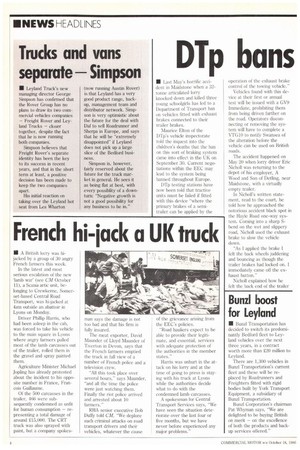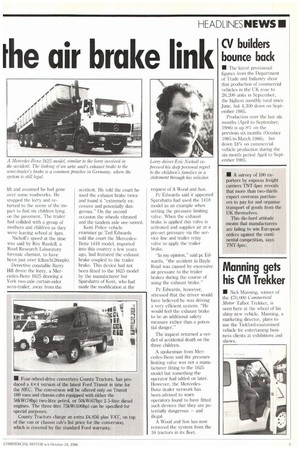Dip bans
Page 6

Page 7

If you've noticed an error in this article please click here to report it so we can fix it.
the air brake link
• Last May's horrific accident in Maidstone when a 32tonne articulated lorry knocked down and killed three young schoolgirls has led to a Department of Transport ban on vehicles fitted with exhaust brakes connected to their trailer brakes.
Maurice Elton of the DTP's vehicle inspectorate told the inquest into the children's deaths that the ban on this sort of braking system came into effect in the UK on September 30. Current negotiations within the EEC may lead to the system being banned throughout Europe.
DTp testing stations have now been told that tractive units must be failed if fitted with this device "where the primary brakes of a semitrailer can be applied by the operation of the exhaust brake control of the towing vehicle."
Vehicles found with this device at their first or annual test will be issued with a GV9 Immediate, prohibiting them from being driven further on the road. Operators disconnecting or removing the system will have to complete a VTG10 to notify Swansea of the alteration before the vehicle can be used on British roads.
The accident happened on May 20 when lorry driver Eric Nichol] was returning to the depot of his employer, A Wood and Son of Detling, near Maidstone, with a virtually empty trailer.
In Nicholl's written statement, read to the court, he told how he approached the notorious accident black spot in the Hayle Road one-way system. Coming into a sharp Sbend on the wet and slippery road, Nichol] used the exhaust brake to slow the vehicle down.
"As I applied the brake I felt the back wheels juddering and bouncing as though the trailer brakes had locked on. I immediately came off the exhaust button."
Nicholl explained how he felt the back end of the trailer lift and assumed he had gone over some roadworks. He stopped the lorry and returned to the scene of the impact to find six children lying on the pavement. The trailer had collided with a group of mothers and children as they were leaving school at 4prn.
Nicholl's speed at the time was said by Roy Rasdell, Road Research Laboratory forensic chemist, to have been just over 421unih(26mph).
Detective constable Barry Hill drove the lorry, a Mercedes-Benz 1625 drawing a York two-axle curtain-sider semi-trailer. away from the accident. He told the court he used the exhaust brake twice and found it "extremely excessive and potentially dangerous." On the second occasion the wheels vibrated and the tandem axle see-sawed.
Kent Police vehicle examiner pc Ted Edwards told the court the MercedesBenz 1418 model, imported into this country a few years ago, had featured the exhaust brake coupled to the trailer brake. This device had not been fitted to the 1625 model by the manufacturer but Sparshatts of Kent, who had made the modification at the request of A Wood and Son.
Pc Edwards said it appeared Sparshatts had used the 1418 model as an example when setting the pressure limiting valve. When the exhaust brake is applied this valve is activated and supplies air at a pre-set pressure via the service line and trailer relay valve to apply the trailer brake.
"In my opinion," said pc Edwards, "the accident in Hayle Road was caused by excessive air pressure to the trailer brakes during the course of using the exhaust brake."
Pc Edwards, however, stressed that the driver would have believed he was driving a very efficient system. "He would feel the exhaust brake to be an additional safety measure rather than a potential danger."
The inquest returned a verdict of accidental death on the three children.
A spokesman from Mercedes-Benz said the pressure limiting valve was not a manufacturer fitting to the 1625 model but something the operator had added on later. However, the MercedesBenz dealer network has been advised to warn operators found to have fitted such devices that they are potentially dangerous — and illegal, A Wood and Son has now removed the system from the 16 tractors in its fleet.
































































































































































































